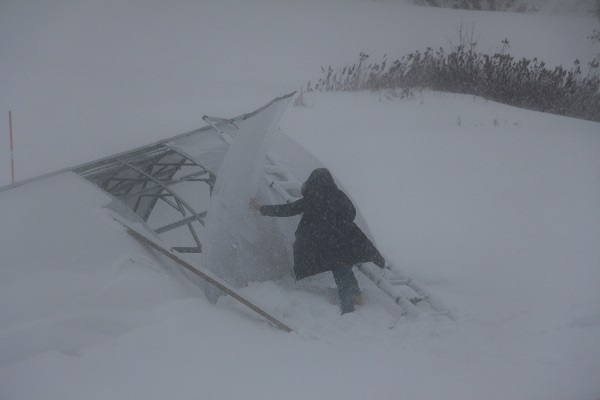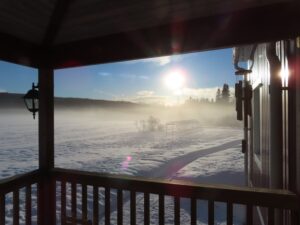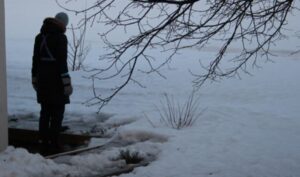2023-03 Snow Disasters
Storm Hits
This month we learnt that a single missing storm tie-down on the greenhouse can spell disaster. All joints in the greenhouse had a tensioned wire holding them in place. The panels also overlapped and there were, screws securing the panels at the bottom, and at the top a metal cap holding the panels down. We didn’t have a tensioned wire holding the middle of the panels down. During a strong winter wind-storm we heard a loud bang and saw a panel from the greenhouse flapping about.
The panel would likely tear itself a part in the wind if not secured but I was on a conference call at the time. My girlfriend went out in the snow to try to secure it. She is walking on top of hard snow that is about 1-1.5m deep in the photo below:

We couldn’t slide the panel back into place during the storm. To do so would mean loosening the guide wires to slide the panel back under the neighbouring panels. Doing that in the storm would lead to more panels coming free. The other problem was that the adjusters for the guidewires were buried under the gravel at the foot of the greenhouse, under the deep snow. After the storm had passed I dug down a trench to the bottom of the panel. This meant clearing a trench about 1m wide, 2.5 meters long, and about 1.5 metres deep. The gravel was frozen solid. We used spare wood to hold the panel down and the new plan was that we’d have to wait for the ground to thaw.
This was a real pain because, with the panel not sealed, the greenhouse wouldn’t be as warm in spring. I formulated a plan to prevent this from happening again. We would attach more fastenings through the panels but again it would need to wait for the snow to melt.
First MOT
I took the car for my first-ever experience with a Swedish MOT test. It wasn’t difficult to understand but the car failed on an exhaust-joint blowing. I booked it in at my local car mechanic who did a quick repair and in my lunch break from work I drove the car home.
Car stuck
The main road was solid ice with fast traffic and a strong wind blowing fresh snow. I braked to enter my drive but on the ice I overshot the point where I would turn-in. I didn’t want to stop or reverse and risk getting rear-ended on the main road. As I turned I put one front wheel into the softer snow to the far side of my driveway. With the snow, it is impossible to see where the ditch is underneath and I was too far over. One wheel was now trapped.
I went to the boot and grabbed a snow-mat to put under the wheel. It should give it the grip needed. I tried again but the wheel span instead of moving. I went to the garage and got the snow shovel and tried to dig the front of the snow pile away. The snow shovel snapped in half, cartoon-style, about halfway through. I put the tyre mats back under the wheel and tried again. Again the wheel didn’t “take” the mat and instead the wheel dug deeper into the snow. When I tried to open the drivers-side door I found the door now hit the snow because the car had sunk. Damn. I was going to make it worse if I tried any more.
This took place immediately opposite a large café, so it must have looked hilarious. It was also below zero and blowing a strong wind.
The car wasn’t a danger to anyone, sat off the road and to the side of the driveway. I was past-due back at work so went back to the house to log in. I was a bit worried because if the snow kept falling then snowploughs would be out on the main road. This meant the car would get hit by a wave of snow and ice as they came past the drive, which might smash a window. I messaged a friend and that evening he came with a towrope and his 4×4 to pull the car out. Knowing the right people can make a serious problem become trivial.
The car went for the retest the next week and passed fine.
Preparation
There was a lot of preparation this month for spring/summer. Once the snow melts the race has already started to get everything ready for planting.
We had found the garden soil thin and undeveloped. Worse, my digging projects had created surplus clay subsoil. Not wanting to throw anything away I had sieved it and mixed it in on some raised beds. It formed an almost waterproof top layer in rain and gave stunted plant growth.
One theory is to focus gardening efforts on improving the soil. Vegetables and other plants are the by-product of that effort. This year is likely our first real concentration on that. We knew we were short on any organic material. Although we have been building up compost heaps we’d not yet had a return from them. Even if they all matured overnight, it wouldn’t be enough this season. We formed a plan. I negotiated with a neighbour for manure in spring. A 3.5m2 trailed of manure would be great. I also contacted a local tree surgeon to get an arrangement on any surplus wood chips.
We also discussed raised bed sizes and types. The current ones had worked but needed a lot of watering. A popular youtube video shows growing inside half-section IBC water containers. The container retains water in the bottom. The theory is that the plants grow deeper roots. As a result the plants become more resistant to summer conditions. An overflow prevented the water level from getting too high. It might have to wait for another year. Food-safe IBC containers are expensive and we have competing projects for budget.
Finances and Tax
It is also the tax-return period. It can be painful having competing financial pressures. There is a large financial commitment for materials in spring but also for paying off any back-tax due. This situation is more complex as a result of cross-border taxation in two countries. Luckily this is my absolute final year of having to claim back tax from the UK. I’ve been on a Swedish payroll since mid-summer of last year. As a result the Swedish tax will become automatic, and the UK tax a empty return.
We’ve been quite aggressive in investing in the property, tools, and bill reduction. The current high inflation rate (8-10%) which makes saving problematic. Although it is important to have a financial buffer, there is a cost to having that buffer during high inflation. The buying power of the savings at 10% inflation decreases by 50% in 3 years.
As a result, I’ve kept an eye out for more ways to invest to reduce bills, but we have completed the easy projects. To reduce bills further needs supporting work that has no direct improvement. An example would be laying underground conduits for electrical wires between the garage and house. Another would be upgrading old fuse boxes to modern circuit breakers (domestic consumer unit in the UK). Adding further insulation to the property is now non-trivial. For example adding insulation to the walls requires 3-4 more projects to be completed at once. As a result, this year might see lots of small supporting tasks completed. Major changes will have to wait for another year.

